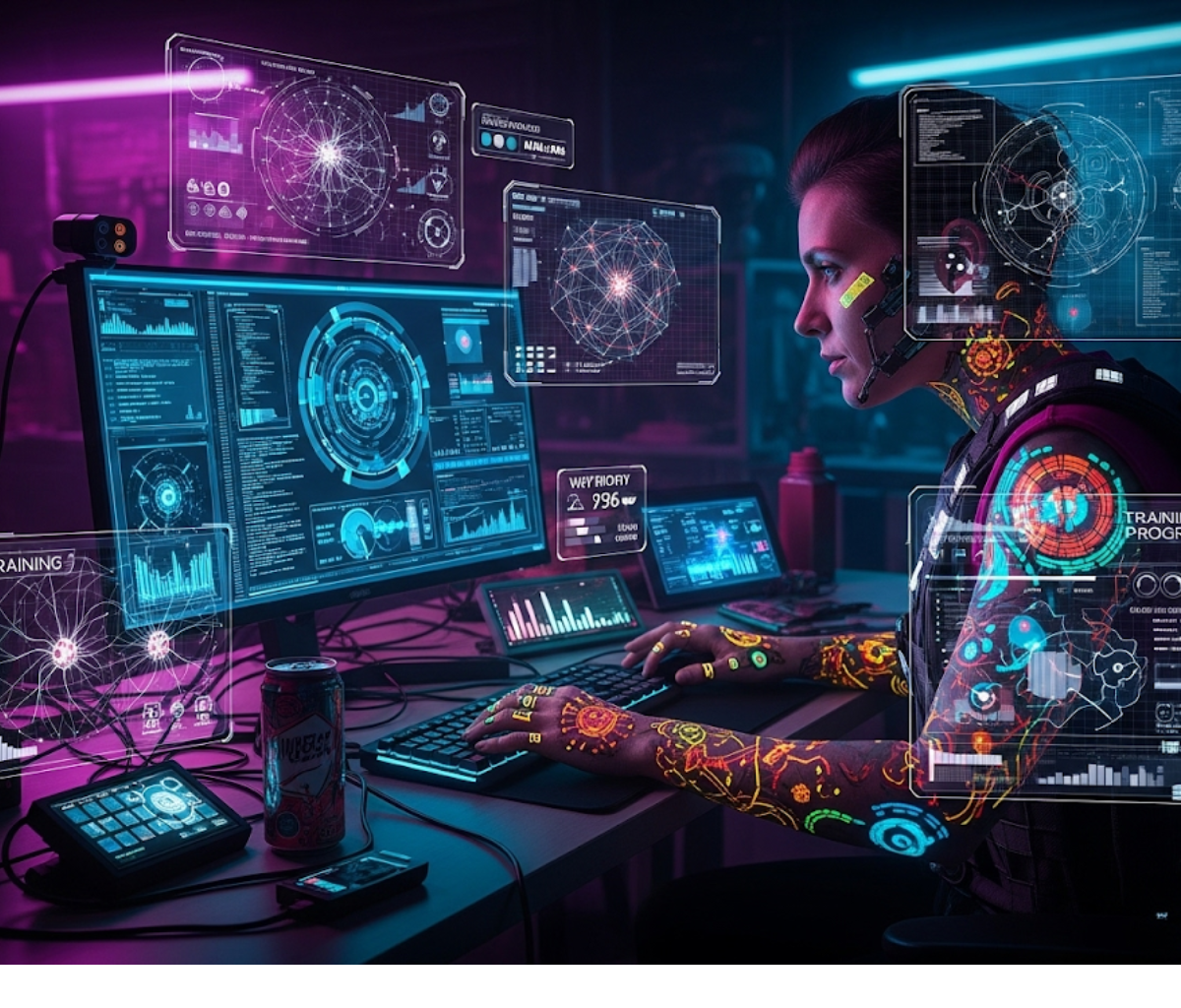On July 10, 2025, Elon Musk’s xAI dropped a bombshell: Grok-4, hailed as the "world’s most powerful AI", boasting Ph.D.-level smarts, seamless multi-modal interactions, and—get this—an uncanny ability to get internet memes and humor. But that’s not all. xAI also unleashed Grok-4 Code (for coding wizards) and Grok-4 Heavy (a multi-agent beast at $300/month). The real showstopper? Grok-4’s "AI Companion" feature—where, for $30/month, you can chat with virtual personas (like Ani and Bad Rudy, your edgy goth confidante) and even unlock "more intimate" dialogue modes. Cue the existential question: "If Grok-4 can simulate personalities… can I train my own unique chatbot?"
Spoiler: Absolutely. While Grok-4 was forged on a monstrous 200,000 H100 GPUs, indie devs and small teams can now craft their own AI sidekicks with Cloud GPU providers like RunC within a click—without breaking the bank. The era of personalized AI is here. Who will you create?
1. The Low-Cost AI Revolution: Fine-Tuning Open-Source Models
Fine-tuning open-source large models is currently the most cost-effective way to obtain high-performance AI. By "standing on the shoulders of giants," it dramatically lowers both technical barriers and costs. Unlike training from scratch—which requires millions of dollars and hundreds of terabytes of data—fine-tuning adapts models to specific tasks for just a few hundred dollars and a few thousand samples, thanks to three key breakthroughs: Parameter-Efficient Fine-Tuning (PEFT) – Techniques like LoRA train only small adapter layers, slashing compute costs; Distributed Training Optimization – Tools like DeepSpeed drastically cut GPU memory usage; Data-Efficient Learning – Methods like curriculum learning boost training efficiency with smart sample selection. Real-world success stories prove the potential: Pusa Video Model – Achieved state-of-the-art results with just $500 in fine-tuning costs (vs. OpenAI Sora's millions); Seed-X Translation – A 7B-parameter model outperformed GPT-4 in specialized tasks. Even consumer hardware gets in the game: With QLoRA, an RTX 4090 can fine-tune a 7B-parameter model, making personalized AI assistants and professional content generation truly accessible.
As AutoML and automation tools evolve, fine-tuning costs will drop further—empowering every developer to build "big-model" AI applications on a small budget. The future? Democratized AI, where innovation isn't limited by resources but fueled by creativity.
Open-Source Model You Can Choose for Personal Training:
- LLaMA 3-8B (Published by Meta company.)
- Mistral 7B (Lightweight and efficient, suitable for conversation)
- DeepSeek-R1 (Published by Tsinghua University, known for its reasoning ability)
Training Bullet Points:
- LoRA/QLoRA (Low-Rank Adaptation)
→ Trains only a small subset of parameters, slashing compute costs
- 4-bit Quantization
→ Drastically reduces GPU memory usage
- Runs on Consumer Hardware
→ Single RTX 4090 capable | Cloud options via RunC platform:
- $0.42/hr for single 4090 rental (no physical GPU needed); From $0.55/hr for dual 4090s (48GB VRAM)
2. How to Give AI "Personality"? The Secret Lies in Training Data
The key to Grok 4's "AI Companion" successfully simulating personality lies in the personalization of its training data. We can adopt similar approaches by selecting the following types of data for fine-tuning:
Diaries/Social Media Posts/Chat Logs
In 2023, programmer Michelle Huang used her childhood diaries to train GPT-3, creating a simulation of her "younger self" that could converse with her present self. She scanned her handwritten diaries, utilized OpenAI's API for fine-tuning (OpenAI's NG-GPT model allows users to perform such fine-tuning), and adjusted relevant parameters to make the AI mimic her specific speech patterns. The final result was a "young Michelle Huang" AI that could accurately predict her current interests and even helped her "reconcile with her past self." This case demonstrates how personal data can transform generic AI into a meaningful, personality-driven companion that offers both functional utility and emotional resonance.
Role-Playing Corpus (e.g., novels, anime dialogues for character modeling)
Some users have successfully created customized AI personalities by deploying Ubuntu LTS environments on cloud platforms and utilizing open-source tools like the nonebot2-based Naturel-GPT chatbot plugin. Through this approach, they've developed AIs capable of role-playing as "catgirls" or game NPCs.
Implementation Process: Model Selection → Choose an open-source base model; Character Design → Write detailed role profiles (background, speech style, etc.); Prompt Engineering → Fine-tune via carefully crafted prompts to maintain consistent characterization; Result → Achieved Grok-4 "Ani"-style AI companions with distinct personalities and quirks, while remaining fully user-controlled with no censorship risks.
Related Blogs about detailed how-to:
How to run Satori-7B-Round2 on RunC.AI
Deploying DeepSeekR1-32B on RunC.AI
3. Train Your AI Companion on the Cloud: A More Affordable and Convenient Option
While fine-tuning open-source models already saves significant costs, purchasing dedicated GPUs (plus electricity and other overhead) remains prohibitively expensive for individual users. Today, GPU rental services have matured—on platforms like RunC AI, you can access an RTX 4090 for just $0.42/hour, with no strain on your local hardware; RunC’s dual 4090 setup costs just $0.55/hour—ideal for heavier workloads. So there are two options on the table: Self-trained AI is in full control, which allows users to customize the digital companion’s personality and behavior, and tailor the AI to their exact preferences. In addition, there are no restrictions from platforms like xAI. In terms of cost, compared to Grok-4 API ($30/month) with minimal customization, cloud training is far cheaper than buying hardware and is more flexible in use.
The Choice Is Yours: Tech-savvy users can opt for cloud-based training for total freedom; Casual users may prefer the plug-and-play API for simplicity.
4. Future Outlook: The Era of Personalized AI Personas
Grok-4's "AI Companion" may just be the beginning—what if we could use a person's lifetime of data to train an AI with their distinct personality? Could this represent a form of digital immortality, preserving someone's essence beyond their physical existence? The concept once confined to cyberpunk fantasies—mind uploading, cybernetic afterlife—may be inching toward reality. As AI learns to emulate human thought patterns, emotions, and quirks through personal diaries, messages, and creative works, we're not just building chatbots. We're potentially creating cognitive mirrors that reflect, and perhaps extend, human consciousness.
Whether you choose to fine-tune your own model or leverage existing APIs, one thing is certain: we're witnessing another transformative leap in AI development - and you're actively shaping this revolution. The tools are now accessible, the costs affordable, and the possibilities endless. What kind of AI companion will you create? A digital twin? A historical mentor? Your favorite fictional character comes to life? The power to build meaningful, personalized AI is no longer confined to tech giants - it's in your hands. We'd love to hear your vision! Share your dream AI project in the comments below at RunC.AI comes Community. Will yours be the next breakthrough that redefines human-AI interaction?
About RunC.AI
Rent smart, run fast. RunC.AI allows users to gain access to a wide selection of scalable, high-performance GPU instances and clusters at competitive prices compared to major cloud providers like Amazon Web Services (AWS), Google Cloud, and Microsoft Azure.


